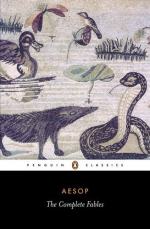|
This section contains 13,549 words (approx. 46 pages at 300 words per page) |

|
SOURCE: "Fables of Power: The Sixteenth Century," in Fables of Power: Aesopian Writing and Political History, pp. 45-80. Durham: Duke University Press, 1991.
In the following essay, Patterson refutes the contention that fables were meant exclusively as moral or educational tools, arguing instead that the English fables of the Middles Ages and Renaissance were intended as political commentary.
O wretch that thy fortunes should moralize
Esops fables, and make tales, prophesies.
Thou 'art the swimming dog whom shadows cosened,
And div'st, neare drowning, for what's vanished.
—John Donne: Satire 5
The history of the fable in the sixteenth century is, from one perspective, continuous with that of the late middle ages. John Lydgate's The Horse, the Goose, and the Sheep, which included comments on the fable's function as a medium of communication, "under covert," of social protest by the poor and their advocates, was printed by Caxton in 1477, and by...
|
This section contains 13,549 words (approx. 46 pages at 300 words per page) |

|


